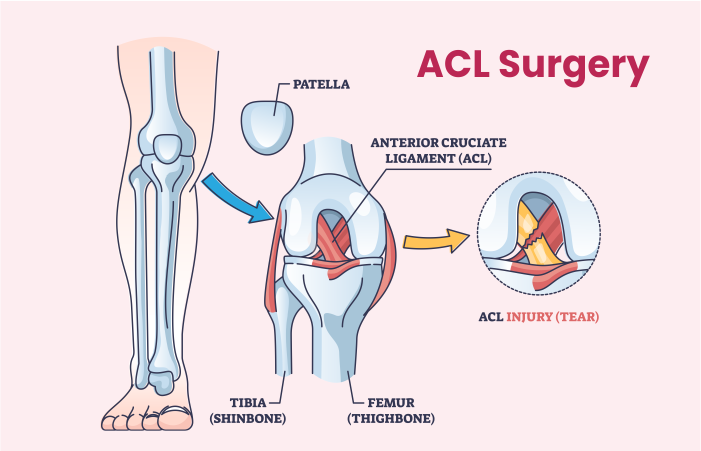ACL Reconstruction Surgery in Hyderabad

ACL Reconstruction
ACL (anterior cruciate ligament) reconstruction surgery is considered the gold standard treatment for individuals with an ACL tear or rupture. It involves the surgical reconstruction of the damaged ligament using arthroscopic techniques. This article aims to provide an overview of ACL reconstruction surgery, including its purpose, preparation, and potential consequences of delaying the procedure. Additionally, it highlights the importance of finding top ACL reconstruction surgeons for optimal treatment outcomes.

What is ACL Reconstruction Surgery?
ACL reconstruction surgery is a procedure that involves the reconstruction or replacement of a torn or ruptured ACL in the knee joint. The ACL is a crucial ligament that provides stability to the knee by preventing excessive forward movement of the tibia (shinbone) relative to the femur (thighbone). Arthroscopic ACL reconstruction is the preferred technique, as it allows for minimally invasive surgery, faster recovery, and better cosmetic results.
Why is ACL Reconstruction Surgery Performed?
ACL reconstruction surgery is performed for several reasons:
Restoring knee stability: The primary purpose of ACL reconstruction is to restore stability to the knee joint. This stability is vital for performing physical activities, sports, and preventing further knee damage.
Resuming normal function: ACL tears often result in limitations in daily activities and sports participation. Reconstruction surgery aims to enable individuals to return to their normal level of activity and regain knee function.
Preventing long-term complications: Delaying or avoiding ACL reconstruction surgery can lead to ongoing knee instability, increased risk of further injury, and the development of secondary problems like meniscal tears or osteoarthritis.
How to Prepare for ACL Reconstruction treatment
To prepare for ACL surgery, follow these general guidelines:
- Consultation with a specialist: Schedule a consultation with a top ACL reconstruction surgeon who has experience and expertise in performing this procedure.
- Preoperative evaluations: Your surgeon may conduct a thorough evaluation, which may include a physical examination, imaging tests (such as an MRI), and reviewing your medical history.
- Education and informed consent: Your surgeon will explain the procedure, discuss potential risks and benefits, and address any questions or concerns you may have. Informed consent is an important part of the preparation process.
- Preoperative instructions: Follow any specific instructions provided by your surgeon, such as fasting guidelines, medication adjustments, and lifestyle modifications leading up to the surgery.
More About ACL Reconstruction Surgery:
Arthroscopic ACL reconstruction is typically performed as an outpatient procedure under general anaesthesia. The surgeon makes small incisions and inserts an arthroscope (a thin tube with a camera) to visualise the knee joint. Through additional incisions, the surgeon removes the damaged ACL and replaces it with a graft, usually sourced from your own body (autograft) or a donor (allograft). The graft is secured using screws, sutures, or other fixation devices.
Postoperatively, a comprehensive rehabilitation program, including physical therapy, is essential. Rehabilitation aims to restore strength, flexibility, and stability to the knee joint, optimize healing, and facilitate a safe return to normal activities and sports.
Consequences of Delaying ACL Reconstruction Surgery
Delaying ACL reconstruction surgery can have several consequences:
- Increased risk of further injury: An untreated ACL tear leaves the knee vulnerable to subsequent injuries, such as meniscal tears or cartilage damage.
- Persistent knee instability: Without surgical intervention, the knee may remain unstable, leading to recurrent episodes of giving way or buckling, which can significantly affect mobility and quality of life.
- Secondary complications: Prolonged ACL deficiency can contribute to the development of long-term knee problems, including meniscal tears, osteoarthritis, and chronic pain.
- Delayed return to sports and activities: Delaying surgery prolongs the recovery timeline, making it challenging to return to sports or physically demanding activities within a reasonable timeframe.
Frequently Asked Questions (FAQs)
ACL reconstruction surgery is a surgical procedure performed to repair a torn ACL in the knee. The ACL is one of the major ligaments responsible for providing stability to the knee joint. The surgery involves replacing the damaged ACL with a graft, usually taken from the patient’s own tissue or a donor, to restore knee stability and function.
ACL reconstruction surgery is typically performed using arthroscopy, a minimally invasive technique. Small incisions are made to insert a tiny camera and specialised surgical instruments into the knee joint. The surgeon removes the torn ACL and prepares the bone tunnels to secure the graft. The graft is then positioned and fixed in place using screws or other fixation devices. The incisions are closed, and the knee is typically placed in a brace or immobiliser following the surgery.
The recovery process after ACL reconstruction surgery is a gradual and progressive journey. It involves a combination of rest, physical therapy, and rehabilitation exercises. Initially, weight-bearing and range-of-motion exercises are introduced, followed by strengthening exercises to regain muscle control and stability. The recovery period can vary depending on individual factors, but typically it takes several months to return to sports and other physical activities.
Like any surgical procedure, ACL reconstruction surgery carries certain risks and potential complications. These may include infection, bleeding, blood clots, graft failure, limited range of motion, stiffness, and the possibility of re-injury. It is crucial to follow the postoperative instructions provided by your surgeon, including proper rehabilitation and activity modification, to minimize these risks and optimize the outcome.
ACL reconstruction surgery aims to restore knee stability and function after an ACL tear. While it significantly reduces the risk of re-injury, it does not guarantee complete protection against future knee injuries. It is important to follow a proper rehabilitation program, strengthen the surrounding muscles, and engage in appropriate warm-up exercises before physical activities to minimize the risk of further knee injuries.









